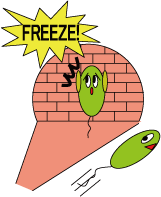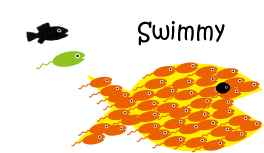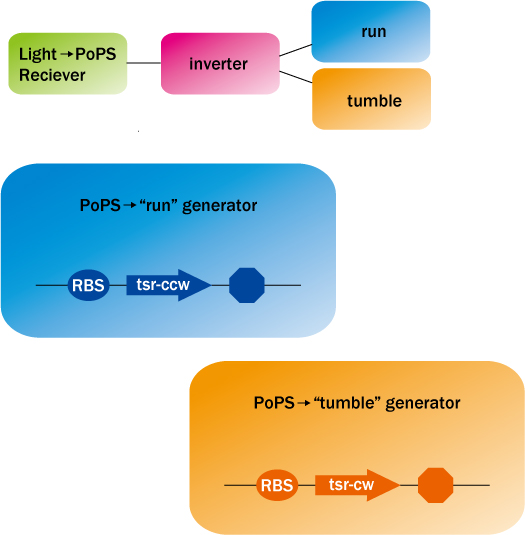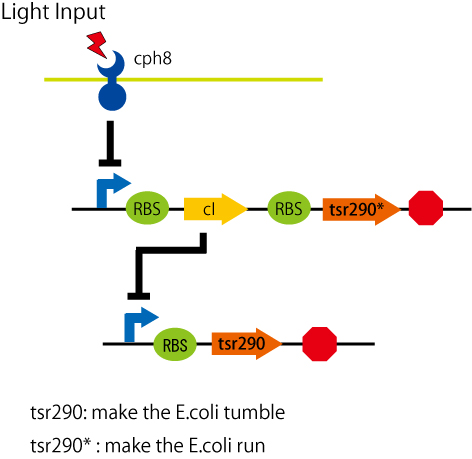Swimmy Bacteria : Chiba 2006
From 2006.igem.org
(Difference between revisions)
(→How it works) |
(→How it works) |
||
| Line 9: | Line 9: | ||
--under construction-- | --under construction-- | ||
| - | to stop the e.coli by light, we needed a part that stop the e.coli, and combine | + | to stop the e.coli by light, we needed a part that stop the e.coli, and combine this with a light receptor that UCSF made it last year. |
| + | there was some ways to stop the e.coli running: | ||
| + | #making a chemaera with chemotaxis receptor and light sensing receptor | ||
| + | #stop the motor protein's expression(motB protein: from last year's parts) | ||
| + | #controling chemotaxis | ||
| + | etc | ||
| - | We've found out, from the paper(..see refrences) the | + | we chose to control chemotaxis. |
| + | We've found out, from the paper(..see refrences), the chemoreceptor that fix the e.coli tumble. | ||
| + | it is a fragment of the chemoreceptor "Tsr" (a serin receptor) | ||
[[Image:Devices.jpg]] | [[Image:Devices.jpg]] | ||
Revision as of 15:07, 29 October 2006
Contents |
Concept
Swimmy Bacteria -- the E.coli freeze and gather when they are caught by red light.


red light on -> stop
red light off -> move
Control the E.coli's movement with light!
How it works
--under construction--
to stop the e.coli by light, we needed a part that stop the e.coli, and combine this with a light receptor that UCSF made it last year.
there was some ways to stop the e.coli running:
- making a chemaera with chemotaxis receptor and light sensing receptor
- stop the motor protein's expression(motB protein: from last year's parts)
- controling chemotaxis
etc
we chose to control chemotaxis. We've found out, from the paper(..see refrences), the chemoreceptor that fix the e.coli tumble. it is a fragment of the chemoreceptor "Tsr" (a serin receptor)
Members
Chiba 2006 team あ
Experiments
light cannon
- 10/15 we wrote a picture at the solid media.(not finished yet) also we changed the arabinose concentration at the liquid media.
- 10/14 the Fluorescent lamp was the best light. we could see the on/off clearly in the solid media. we found that the thin media is better than the thicker one.
- 10/11 we changed the arabinose & S-gal's concentration & the light sorce to find the best condition.
swimmy
- 10/15 tried the capiraly assay to see chemotaxis. also we washed the e.coli and observed it with the microscope(but it was kind of hard)
- 10/11 we're finding the suitable media to observe the E.coli's movement(chemotaxis).
- 8/23 we made the tsr gene parts by PCR & discussed about the locked Tsr mutants.
Todo List
Referenses
Locked Tsr Mutants
- A.Bren and M.Eisenbach (2000) -- How Signals Are Heard during Bacterial Chemotaxis: Protein-Protein Interactions in Sensory Signal Propagation (J.Bacteriol.)
- P.Ames and J.S.Parkinson (1988) -- Transmembrane Signaling by Bacterial Chemoreceptors: E.coli Transducers with Locked Signal Output (Cell)
- P.Ames and J.S.Parkinson (1994) -- Constitutively Signaling Fragments of Tsr, the Escherichia coli Serine Chemoreceptor (J.Bacteriol.)
Experiments
- Microscope -- Real-time imaging of fluorescent flagellar filaments.J.bacteriol.2000
- Chemotaxis Assay -- J.Adler -- A Method for Measuring Chemotaxis and Use of the Method to Determine Optimum Conditions for Chemotaxis by Escherichia coli
- M.K.Slocum and J.S.Parkinson (1985) -- Genetics of Methyl-Accepting Chemotaxis Proteins in Escherichia coli: Null Phenotypes of the tar and tap Genes (J.Bacteriol.)
- J.S.Parkinson (1976) --- cheA, cheB, and cheC of Escherichia coli and Their Role in Chemotaxis (J.Bacteriol.)
Last Update
- 10/13 todo list
- 10/11 swimmy & gene pathway
- 8/23 refrences
- 8/7 concept&members --maiko

